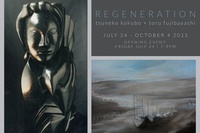"Regeneration" art exhibition in Kaslo, BC
| Jul 201524 | — | Oct 20154 |
Langham Hotel
447 A Avenue
Kaslo, British Columbia, V0G 1M0
Canada

The Regeneration exhibit evokes a minimalist design and aesthetic – like a Japanese-style garden of contemplation – with its tightly bounded compositions of gravel and rocks and sparse vegetation. The artists involved: Tsuneko Kokubo & Toru Fujibayashi are senior artists with extensive, fascinating and variant backgrounds. Both artists experienced various aspects of Canada’s Internment policy of Japanese Canadian citizens during the Second World War, an occurrence which deeply influenced their lives. At the same time, there is a sense of weariness which attends this association. It is important to give context to the history but not hang a definitive or simplistic placard around the exhibition or artists involved. To put too fine a point on ethnicity or blame/credit all influence on such blatant and egregious ethnocentrism, takes away from the individuality of the artists themselves, and of course, their work. The Internment issue is both an ever-present and yet oftentimes uninvited presence, and both artists acknowledge and/or disregard this influence in interesting ways. Regeneration, at its root, is about memory – what is retained and how it manifests itself in the world.
There is a misty-memory quality to Koko’s figurative and impressionistic pieces; parts of poems, writ large. They are delicate and dramatic. She has melted herself into the past and onto the surface of each piece. She is the abandoned fishing boat on the Fraser River; the girl in the kimono clutching the doll; she is the fish that flashes in the water. Fluidity of form and dreamy disparateness connote both traditional influences and a highly personalized evocation of everyday and exceptional events.
Alissa J. Rubin addresses something similar in her article “Horror is a Constant, as Artists Depict War.” (New York Times, August 28th, 2014).
The vocabulary of war, whether images or words, must be reimagined by each new generation of artists as it seeks to depict the consequences of conflict … today’s artists are not alone …[t]heir predecessors have given them a way to see, and to transform, even the most nihilistic of history’s moments into something with meaning.”
Koko, like Francisco de Goya, Kitaoka Fumio, and Fiona Banner, creates a visual, emotional and intellectual response to societal issues too vast and convoluted to address in other ways. The creation of beauty out of chaos is a response to conflict and one which Koko has choreographed through multiple mediums over a life-time of re-envisioning reality.
Toru’s work is as concrete and elemental as stone sculpture can be. Not soft, of course, but highly polished, and smooth, affecting/effecting flow or flowering, rupture and eruption with a subtle but strong physicality in flushed tones of black and white and grey all over. There is a quiet dignity to these works; they carry great weight (literally and figuratively) but with sensitivity. We are accustomed to sculpture being: commemorative, symbolic, representative, decorative, but we are less familiar with seeing sculpture as an exercise in the acceptance and adoration of form. Toru’s work exudes that type of symbiotic self-determination which Michelangelo described when he said, “Every block of stone has a statue inside it and it is the task of the sculptor to discover it.” In the tradition of: Eric Gill, Henri Gaudier-Brzeska, Ben Nicholson, Barbara Hepworth, Constantin Brancusi, Henry Moore, and Isamu Noguchi, Toru’s work evokes that same ‘rightness of form’, that fascinating feeling that one gets when they see a work of art that seems (somehow) exactly as it should be. This is what happens when artists find their medium and are so attuned to the application of their craft that they “tap into something called “nondeclarative memory” or “procedural memory”—a recall of motor skills and tasks that have been learned and retained almost automatically, such as riding a bike” (Exploring the Link Between Art and Memory, by Michael Anft, Johns Hopkins Magazine, Nov.30th, 2011). The simple elegance of these works is due to this type of organic creation; a wellspring of artistic observance combined with life-long-learned practice.
Regeneration, at its heart, is a way of seeing; a study of memory and the motivations and methods with which we are able to understand lives lived. As the title tells us, these works are about life and death, but they also give us a glimpse of the doing in between.
Arin Fay, Curator (2015)
 Masaji
.
Última actualización Ago 02, 2015 6:34 a.m.
Masaji
.
Última actualización Ago 02, 2015 6:34 a.m.

 Journal feed
Journal feed


Exhibition